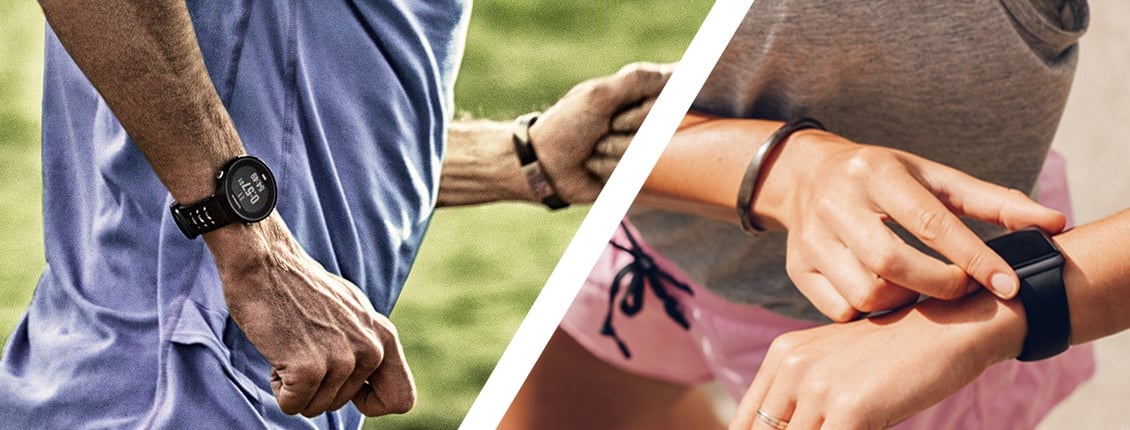
What’s the difference between fitness trackers, activity trackers and smartwatches?
When it comes to wearable tech, it’s not cut and dried
Ever since Dick Tracy sported his 2-way wrist radio, and later, his 2-way wrist TV, adding tech to the wrist has fueled the imagination.
But when it comes to today’s wrist tech, the terms are not so self-explanatory. The typical definitions are:
- A fitness tracker tracks things related to fitness
- An activity tracker specializes in a particular activity or set of activities
- Smart watches do all kinds of things
Although all of that is true, it’s too simple of an explanation.
The fitness tracker or fitness band
- These are typically characterized by a narrow band made from a synthetic material and sport a simple, LED-type display window
- They count steps—or arm swings as steps—and may be able to measure heart rate and sleep habits
- These devices are comfortable to wear over long periods of time
- They aren’t complicated to use
- Bluetooth connectivity is rare
- They have a long battery life
- They are less expensive than the others
- The sole goal is fitness, with the hope of changing behavior
The activity tracker
- Activity trackers are a sort of hybrid between fitness trackers and smart watches
- Or, sometimes the name is used interchangeably for fitness tracker—or a fitness tracker with some kind of Bluetooth connectivity and some apps
- It may be designed for a particular sport, like running, so sport watch could be another term used to describe these kind of watches
- The band is generally synthetic but the tracker’s face is larger than a fitness tracker
- It usually monitors heart rate, probably has GPS capability as well as Bluetooth, has sensors for altitude, barometric pressure, etc. and training tools to make workouts more effective
- It may even have internal storage for music
- Battery life may be measured in hours, days or weeks, depending on what options are being used
There are now models with high-end bands and incredibly sophisticated looks. Some even have real, mechanical hands that move out of the way to reveal other features and even contactless payment apps!
Activity trackers, depending on the specialty, can cost more than a smartwatch. This makes the difference between activity trackers and smartwatches a slippery slope.
The smartwatch
- Smartwatches sit at the top of fitness wearables
- They tend to mimic the look of wristwatches
- Smartwatches don’t just notify when there’s an email or text message, they may even display the message
- Many can store music
- Some can even let you make and take phone calls
- They are larger than fitness bands, making them less comfortable to wear during longer workouts
- Battery life ranges greatly, depending on what features are enabled at any given time
So a major difference between a fitness tracker and a smartwatch is that fitness trackers are designed for monitoring and gathering data while smartwatches are built for communication. Fitness awareness is there, too, by counting steps, measuring heart rate, and so on, but is complemented by a wide variety of apps that have nothing to do with fitness.
Smartwatches are growing in popularity, accounting for about 30% (and climbing) of the wearables market. Apple, Samsung, and FitBit lead the pack. Traditional watchmakers like Fossil and fitness-based Garmin are growing in market share, too.
“Over the last 18 months, smartwatch sales gained strong momentum, proving the naysayers, who didn’t think the category could achieve mainstream acceptance, had potentially judged too soon,” said Weston Henderek, director, industry analyst for NPD Connected Intelligence. “The ability to be truly connected via built-in LTE without the need to have a smartphone nearby proved to be a tipping point for consumers, as they now recognize the value in being able to complete a wide range of tasks on the device including receiving notifications, messaging, accessing smart home controls and more.”
That’s right—accessing smart home controls. Approximately 15% of smartwatch owners use their devices to control home automation devices!
What’s ahead for wearable tech?
Expect battery life to improve among activity trackers and smartwatches. Expect the price gap between fitness trackers and smartwatches to narrow. And expect the differences between activity trackers and smartwatches to blur even more. The fitness tracker should remain less costly but may add some additional capabilities to further bolster its appeal.
Don’t expect the confusion over terms to get better any time soon.
There’s more to wearable tech than devices worn on the wrist! Other up-and-coming devices include smart eyeglasses, smart clothing, and smart earphones and headphones.
Tech on the wrist has come a long way. We’re not quite at the Dick Tracy stage, but we’re very close.
Be sure to check out wholesale wearable tech available from order.petra.com
